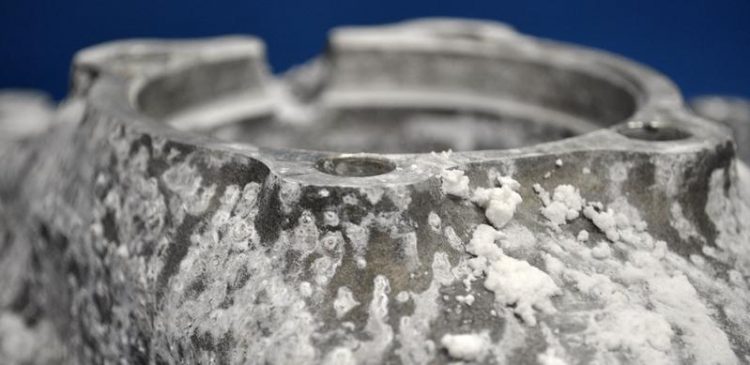Complex Loading versus Hidden Reserves

Corrosion can have a major effect on the behavior of components. Photo: Fraunhofer LBF
The durability of materials, components or constructions is sometimes reduced greatly due to complex load conditions. These effects must be taken into consideration, particularly for safety components. Furthermore, products have to be produced in an easy, cost-effective, efficient manner – diametrically opposed challenges. At the International Symposium on Structural Durability in Darmstadt, Germany, on May 17-18, 2017, experts will discuss complex load situations and how they can be assessed realistically. For more information, see www.sosdid.de
Structural durability includes the design, measurement and stability of components and systems in relation to loads. These requirements are extremely complex; material utilization is increasing, while a focus is being placed on lightweight construction. Today’s configurations have fewer and fewer “hidden reserves.” The design strategy, determination of the design-relevant loads, and assessment of a component’s strength are becoming more and more complicated.
At the fifth Symposium on Structural Durability in Darmstadt (SoSDiD) on May 17-18, 2017, at the Maritim Conference Hotel, international experts on structural durability will present the latest findings in structural durability. Experts from the industrial and financial sectors will report on the topic of “Complex Loading.” During three feature presentations, “Environmentally Assisted Fatigue,” “Variable Amplitude Loading” and “Random Vibration,” the influence of media, temperature changes, and variable load amplitudes on the structural durability of components will also be discussed with participants.
The accompanying exhibition will showcase highly specialized tools and provide information on current measurement and testing options, as well as new software for the complex topic of structural durability.
Advancing methods and design concepts
The conference is a lively forum for discussing basic questions and current trends regarding component reliability and safety. At the same time, it offers the opportunity to network in Darmstadt, a research location steeped in tradition. For over a decade, Darmstadt has been a center for research in structural durability. Test and measurement equipment, calculation methods and design philosophies have been developed here. Traditionally, research institutes have held the Symposium on Structural Durability in Darmstadt in cooperation with leading local manufacturers of servo-hydraulic test systems and components as well as an internationally recognized market leader of measurement technology, taking a closer look at the continuity of the activities in this area with the common goal of advancing methods and design concepts for future materials and products.
On the lookout for young talent
For the first time ever, the 2017 event will feature a “Young Talents Session.” Experts are aiming to find the next generation of talent early on, calling for keen young engineers to make brief presentations on their topic.
SoSDiD Organisation Comittee:
Fraunhofer Institute for Structural Durability and System Reliability LBF
Institute of Steel Construction and Materials Mechanics (IFSW), Technische Universität Darmstadt
System Reliability, Adaptive Structures and Machine Acoustics SAM, Technische Universität Darmstadt
Institute for Materials Technology / State Materials Testing Institute (IfW/MPA), Technische Universität Darmstadt, Adam Opel AG, Hottinger Baldwin Messtechnik GmbH (HBM), Instron GmbH
Media Contact
More Information:
http://www.lbf.fraunhofer.deAll latest news from the category: Event News
Newest articles

Properties of new materials for microchips
… can now be measured well. Reseachers of Delft University of Technology demonstrated measuring performance properties of ultrathin silicon membranes. Making ever smaller and more powerful chips requires new ultrathin…

Floating solar’s potential
… to support sustainable development by addressing climate, water, and energy goals holistically. A new study published this week in Nature Energy raises the potential for floating solar photovoltaics (FPV)…

Skyrmions move at record speeds
… a step towards the computing of the future. An international research team led by scientists from the CNRS1 has discovered that the magnetic nanobubbles2 known as skyrmions can be…





















